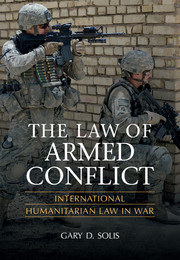Book contents
- Frontmatter
- Contents
- Table of Cases
- Table of Treaties
- Foreword
- Preface
- Acknowledgments
- LAW OF ARMED CONFLICT: INTERNATIONAL HUMANITARIAN LAW IN WAR
- LAW OF ARMED CONFLICT AND INTERNATIONAL HUMANITARIAN LAW: A FRAMEWORK
- LAW OF ARMED CONFLICT AND INTERNATIONAL HUMANITARIAN LAW: BATTLEFIELD ISSUES
- 9 Obedience to Orders, the First Defense
- 10 Command Responsibility and Respondeat Superior
- 11 Ruses and Perfidy
- 12 Torture
- 13 Rules of Engagement
- 14 Targeting
- 15 Attacks on Cultural Property
- 16 The 1980 Certain Conventional Weapons Convention
- 17 Gas, Biological, and Chemical Weapons Treaties
- References
- Index
- References
13 - Rules of Engagement
from LAW OF ARMED CONFLICT AND INTERNATIONAL HUMANITARIAN LAW: BATTLEFIELD ISSUES
- Frontmatter
- Contents
- Table of Cases
- Table of Treaties
- Foreword
- Preface
- Acknowledgments
- LAW OF ARMED CONFLICT: INTERNATIONAL HUMANITARIAN LAW IN WAR
- LAW OF ARMED CONFLICT AND INTERNATIONAL HUMANITARIAN LAW: A FRAMEWORK
- LAW OF ARMED CONFLICT AND INTERNATIONAL HUMANITARIAN LAW: BATTLEFIELD ISSUES
- 9 Obedience to Orders, the First Defense
- 10 Command Responsibility and Respondeat Superior
- 11 Ruses and Perfidy
- 12 Torture
- 13 Rules of Engagement
- 14 Targeting
- 15 Attacks on Cultural Property
- 16 The 1980 Certain Conventional Weapons Convention
- 17 Gas, Biological, and Chemical Weapons Treaties
- References
- Index
- References
Summary
Introduction
At Bunker Hill, in 1775, William Prescott (or was it Israel Putnam?) is said to have ordered his Continental rebels, “Don't shoot until you see the whites of their eyes.” Because the order specified the circumstances in which deadly force could be employed by infantry forces it could be considered an early rule of engagement. (Except it is too clear and too brief to qualify.)
Rules of engagement (ROE) are not law of armed conflict (LOAC) or international humanitarian law (IHL). They are not mentioned in the Geneva Conventions or Additional Protocols, and they are not the subject of a multinational treaty bearing on armed conflict. Nor are they are domestic law. They are military directives, heavy with acronyms. ROE are examined here because they play a significant role in executing the state's LOAC/IHL obligations and because they are frequently cited when LOAC/IHL violations are alleged. Most states' armed forces have some version of ROE to guide their combatants. (The record of UN peace-keeping forces and their ROE implementation has been troubled, making a “strong [UN] response to provocation close to impossible.”) Although not LOAC/IHL, ROE violations are typically punished through the state's military code. In U.S. practice, violations are prosecuted as violations of a lawful general order, a common Uniform Code of Military Justice offense.
- Type
- Chapter
- Information
- The Law of Armed ConflictInternational Humanitarian Law in War, pp. 490 - 518Publisher: Cambridge University PressPrint publication year: 2010



